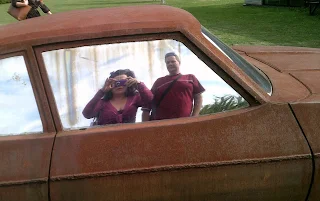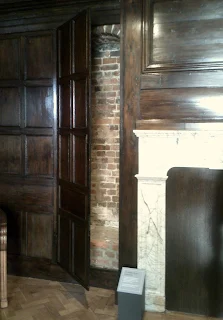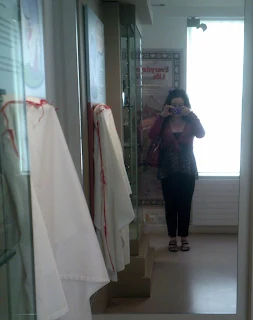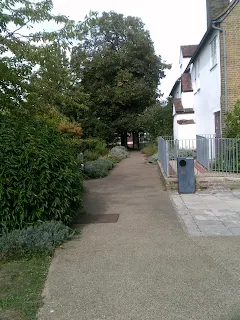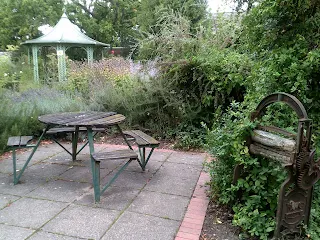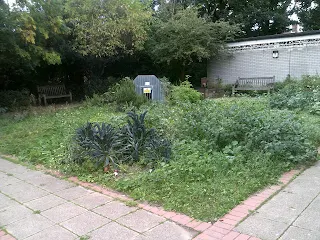Valence House is the only surviving manor house in Dagenham. Dating back to medieval times (a house was first established on this site in the 13th century) and partially surrounded by a moat, it was refurbished extensively as a museum in 2010. I only found out about it recently and wish I'd known about it before as it's only a short 20 minute bus ride away from where I live and is a (to use a much-worn but accurate phrase) hidden gem! Okay then, I'll be different and call it a hidden jewel... 😉
Valence House holds 200,000 artefacts, dating from Prehistory to the modern day, plus material from local Barking and Dagenham archaeological digs.
We had an easy ride of it getting there and back- in both instances the bus rocked up just as we reached our stop.😊
You have to walk behind the library to reach the house. In front of the library is an installation of a rusty Mark 2 Capri. Well, I'm assuming it's art and not a car that was stolen, joyridden and burnt out the night before!
Here's a photo of the me 'n' the SuperDean reflected in the mirrored windows...
The view back over the grass. The museum is to the right..
The museum entrance...
This more bucolic view was taken after we'd walked by the lake...
In the first room we learnt about the history of the house and here is a model of the site as it was in 1921...
In the second room, we were greeted by this little guy- he is the Dagenham Idol and was found locally in 1922. He is made of wood and dates to around 2250BC, making him one of the oldest human representations in Europe. By the way, the Dagenham Idol is not to be confused with Pop Idol, won by local girl Stacey Solomon. Or was it X Factor? And was she just a runner up? Either way...
This room also contains a grand piano...
...and a khazi! The smallest room in the house would have contained peat, which was changed regularly...
Moving on and we have a Roman skeleton and sarcophagus...
This section is dedicated to Roman times and it is possible to dress up in a toga (shown to the left of the photo). Dean tried but it's obviously meant for kids as it was w-a-a-a-y too small for him. Oh, and we also have to have a Vain Old Tart reflection...
The next section is about famous people who were born in or who resided in the area. Singers Sandie Shaw and Billy Bragg got a mention, as well as a selection of footballers. It also mentions iconic visitors, one of whom was Mahatma Gandhi, who was in the area in 1931...
There is a lot going on in this section, with cabinets dedicated to how people both worked (the Ford car plant in Dagenham gets a mention, of course) and played. There is a cabinet full of trophys and the women's movement gets a mention.
I had to include this cabinet featuring a suffragette, as us women nowadays take so much for granted; things that these gutsy ladies- and more women since then (I'm thinking in particular of the campaign for equal pay)- had to fight for.
A Becontree kitchen. I believe this is based on homes during the Second World War...
This is definitely wartime as there was a gas mask on the floor, just out of shot. I love the rag rug on the floor (I knew a woman who used to make these- a fine way of recycling fabrics).
Medicines and medical implements...
Toy cabinet...
I absolutely loved my dollies as a child- they were my WORLD! I once said to my mum, 'Dolls are not just dolls- they are little children who have died...' She said it was the creepiest thing anyone had ever said to her!!!!
Mayoral robes...
I took this view out of the window simply because I loved the tree with red berries...
And I took this photo because stairs always interest me and I like the cough candy twist curly balusters...
A silver chest. Or rather, a chest for holding silver...
Whaling took place locally and this is the bone of a whale's jaw. really, it was HUGE! I had to stand back into the next room to fit all of this picture in...
Dresses also formed part of the museum's exhibitions...
Original walls. The top one belonged to the pantry...
There is an exhibition entitled 'Copying the Fanshawes' running until March 2019. It describes how copies often exist of famous paintings- some by the original artist and some not- and why this was common practice during the 17th and 18th centuries. Portrait painting was often used, by rich people (it was an expensive business, after all) to commemorate special occasions. People would commission them to give as gifts or, if they owned more than one property, to display in each of their homes.
Valence House estate was acquired by William Fanshawe in 1619 and remained within the family for nearly three centuries, until Evelyn John Fanshawe sold it to the London County Council in 1916.
This is Captain Aubrey Basil Fanshawe (1893-1973) who donated some fifty portraits of members of the family to Valence House Museum in 1963.
Sarah Fanshawe (1642-1717) was a renowned beauty of her day. This portrait does her justice- visit the exhibition and you'll see that the copy does not, and succeeds in making her look rather hard-faced.
Anne, Lady Fanshawe (1607-1628). She died giving birth to her first baby.
There are several more portraits other than these- I just took photos of the few that really appealed to me.
We then took a walk outside, past the library. Here is part of the partial moat.
These geese did not want to be photographed and showed me their bums!
But on the lake around the corner they acquiesced...
One end of the lake...
T'other and there are fishermen right at the end...
Lake island...
We walked back to the cafe for coffee. Inside it was very clean and relaxing, and everything was very reasonably priced...
...with nice homely touches such as these herbs...
...taken from the herb garden (which is a little lane that is actually on the way out)...
I made a friend in the shape of Mr. Agnes. He was called Agnes until they discovered he was actually a boy! He was told off (and slung out) for wandering into the cafe...
We entered the garden via this seating area with an old-fashioned mangle in the corner...
The summerhouse...
Ditto, with someone being a pest...
The bowery...
I liked this ivy-covered tree...
Wartime garden...
Air raid shelter...
Compost heap. My dad had one of these in our garden...
I took a photo of these Black-eyed Susans as we left. I like this flower, although it does have a 'scary' look about it. Maybe it's that combination of yellow and black together (wasps, tigers, traffic wardens, SuperDeans whenever they dress in bad fashion combinations, etc...)
You wouldn't believe that such a lovely place is huddled away behind the quiet residential and sprawling urban, chicken-shop-infested streets of Dagenham but it was a calming way to spend a couple of hours and I'll definitely return.
TTFN
The Miss Elaineous
XXXXXXXXXXXXXXXX
XXXXXXXXXXX
XXXXXXXX

